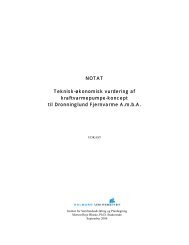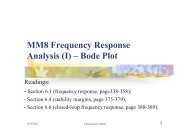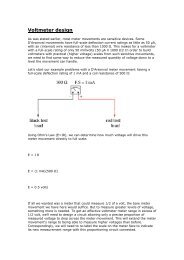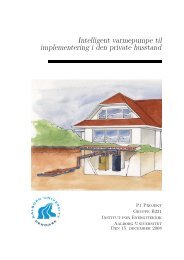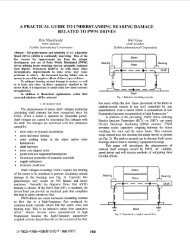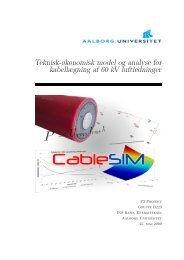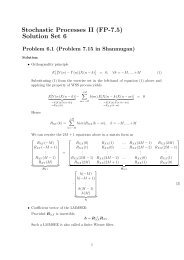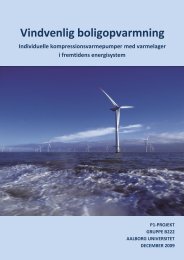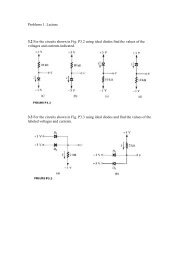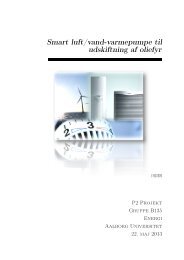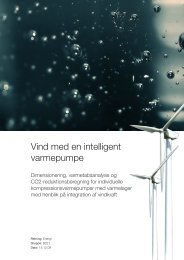Chapter 13 Gas Turbine Power Plants
Chapter 13 Gas Turbine Power Plants
Chapter 13 Gas Turbine Power Plants
Create successful ePaper yourself
Turn your PDF publications into a flip-book with our unique Google optimized e-Paper software.
<strong>Chapter</strong> <strong>13</strong><br />
<strong>Gas</strong> <strong>Turbine</strong> <strong>Power</strong> <strong>Plants</strong><br />
<strong>13</strong>.1 Introduction<br />
The simplest form of gas turbine requires three components: the<br />
gas turbine itself, a compressor, and a combustor in which fuel is<br />
mixed with air and burned. These three basic elements are depicted<br />
schematically in Figure <strong>13</strong>.1. The system comprising these<br />
three components is an external-combustion engine, as opposed<br />
to an internal-combustion engine. The latter type of engine is discussed<br />
in <strong>Chapter</strong> 11.<br />
Air In<br />
Combustor<br />
Compressor<br />
<strong>Turbine</strong><br />
Figure <strong>13</strong>.1 Basic gas turbine power plant<br />
Exhaust
The gas-turbine engine can be used to produce large quantities<br />
of electric power and thus to compete with the steam turbine<br />
power plant. <strong>Gas</strong> turbines can also be used to produce small<br />
amounts of power, as in auxiliary power units. They can be used<br />
to power ships as well as ground vehicles like tanks, trains, cars,<br />
buses, and trucks, and, of course, gas turbines are widely used to<br />
power aircraft.<br />
Figure <strong>13</strong>.2 Thermodynamic cycle for gas turbine power plant<br />
The thermodynamic cycle which comprises the basic processes<br />
of a gas turbine power plant is called the Brayton cycle. In<br />
Figure <strong>13</strong>.2 the Brayton cycle is shown on the T-S plane. It comprises<br />
four processes: process 1-2' represents the adiabatic compression<br />
in the compressor, process 2'-3 traces states in the constant-presssure<br />
heating of the combustor, process 3-4' is the adiabatic<br />
expansion of the gas in the turbine, and process 4'-l represents<br />
the constant pressure cooling process in the atmosphere.<br />
When the compression and expansion processes are isentropic, as
in the cycle 1-2-3-4-1, the cycle is called the ideal Brayton cycle.<br />
The thermal efficiency of the ideal Brayton cycle is a function of<br />
pressure ratio pjpi, and its value is the highest possible efficiency<br />
for any Brayton cycle at a given pressure ratio.<br />
The thermal efficiency of any cycle is defined by (5.30). In the<br />
Brayton cycle the net work is the algebraic sum of the turbine<br />
work W t , which is positive, and the compressor work W c , which is<br />
negative; thus, the thermal efficiency is written as<br />
W +Wc<br />
'<br />
QA<br />
(<strong>13</strong>.1)<br />
where Q A is the energy added to the flowing gas in the combustor<br />
as a result of the exothermic chemical reaction which occurs as<br />
the fuel burns in air.<br />
In the following sections the methods for computing W t , W c ,<br />
and Q A will be shown for the ideal Brayton cycle, the standard<br />
Brayton cycle, and for variations on the Brayton cycle which involve<br />
the use of heat exchangers. Finally, the combined cycle,<br />
Brayton plus Rankine, is considered.<br />
<strong>13</strong>.2 Ideal Brayton Cycle<br />
For the ideal cycle we can assume that the working fluid is cold<br />
air, i.e., a gas having a molecular weight of 28.96 and a ratio of<br />
specific heats y of 1 .4, and that the air behaves as a perfect gas.<br />
The compression and expansion processes are isentropic for the<br />
ideal cycle. According to (5.21) work for compression is given by<br />
W c =h ol -h m (<strong>13</strong>.2)<br />
where any change in potential energy is assumed negligible, and<br />
the solid boundaries of the compressor are assumed to be adiabatic.<br />
Assuming that the working substance is a perfect gas and
applying (2.34) and (2.35) to the right hand side of (<strong>13</strong>.2), we<br />
obtain<br />
W c =c p (T ol -T 02 ) (<strong>13</strong>.3)<br />
where T 0] and T 02 are the total temperatures at stations 1 and 2,<br />
respectively. Total temperature T 0 refers to the temperature<br />
achieved when the flow is decelerated adiabatically to a negligible<br />
velocity; it corresponds to the total enthalpy h 0 defined by<br />
(12.16).<br />
Using the same method employed to derive (<strong>13</strong>.3), when the<br />
steady flow energy equation is applied to the turbine, we find that<br />
w t = Cp (T m -T M ) (<strong>13</strong>.4)<br />
For the steady-flow energy balance on a control volume that<br />
encloses the combustor, in which the combustion process is supplanted<br />
by an equivalent heat transfer process between an external<br />
energy source and the flowing air, the equivalent heat transfer<br />
Q A is given by<br />
QA=c f (T m -T n ) (<strong>13</strong>.5)<br />
Finally, substitution of (<strong>13</strong>.3), (<strong>13</strong>.4), and (<strong>13</strong>.5) into (<strong>13</strong>.1)<br />
yields an expression for the thermal efficiency of the ideal Brayton<br />
cycle in terms of the absolute temperatures of the four end<br />
states, i.e.,<br />
=<br />
i<br />
T -T<br />
•'OS -*02<br />
In lieu of the temperatures, or temperature ratios, found in<br />
(<strong>13</strong>.6), it is possible to substitute pressure ratios using
- r<br />
^02 ~ -'<br />
and<br />
(<strong>13</strong>.8)<br />
which are derived as indicated in Section 2.8 and in Problem<br />
2.12. Equation (<strong>13</strong>.7) is the p-T relationship for the isentropic<br />
compression process, and (<strong>13</strong>.8) is the p-T relation for the isentropic<br />
expansion process. When the pressure ratios in the two<br />
eqautions are replaced by the cycle pressure ratio r p and substituted<br />
into (<strong>13</strong>.6), the resulting ideal Brayton cycle thermal efficiency<br />
is<br />
(<strong>13</strong>.9)<br />
where the exponent a equals (y - l)/y. Although the ideal efficiency<br />
is seen to depend solely on the cycle pressure ratio, the<br />
Brayton cycle 01-02'-03-04'-01 in Figure <strong>13</strong>.2 depends as well<br />
on the turbine inlet temperature T 03 . This is shown in the next<br />
section.<br />
<strong>13</strong>.3 Air Standard Brayton Cycle<br />
To introduce greater realism into the Brayton cycle analysis<br />
we can use compressor and turbine efficiencies. For the compressor<br />
we will utilize the definition already given in (12.18). Referring<br />
to Figure <strong>13</strong>.2 for states, the compressor efficiency becomes
h or -h ol<br />
which is the ratio of isentropic specific work to actual specific<br />
work. Similarly, the turbine efficiency is defined as the actual<br />
work over the isentropic, i.e.,<br />
l,-* 5 (<strong>13</strong>-11)<br />
Both compressor and turbine efficiencies range from between 80<br />
and 90 percent for larger power plants down to 70 to 80 for auxiliary<br />
power units.<br />
If the cycle pressure ratio r p and the entering temperatures are<br />
known, the isentropic compressor and turbine works are easily<br />
computed. Knowing the temperature T 0} of the entering air, the<br />
actual compressor work is computed from<br />
where the exponent a = (y - l)/y. Note that (<strong>13</strong>.12) yields a positive<br />
value; thus, Wc denotes here the magnitude of the compressor<br />
work.<br />
Similarly, if the turbine inlet temperature T 03 is known, the<br />
actual turbine work is given by<br />
The heat transfer equivalent of the energy addition resulting<br />
from combustion is given by
Q A =C p (T 03 -T 02 .) (<strong>13</strong>.14)<br />
where T 02 - is calculated from (<strong>13</strong>.10), i.e.,<br />
(<strong>13</strong>.15)<br />
Finally, the cycle thermal efficiency T] can be calculated by<br />
substituting the above equations into the equation,<br />
W -W<br />
^ = ^-^- (<strong>13</strong>.16)<br />
where the numerator has been expressed as a difference, since W c<br />
represents the magnitude of the compressor work.<br />
The graphs of Figure <strong>13</strong>.3 were determined by using the<br />
methods outlined above. The variation of cycle thermal efficiency<br />
with cycle pressure ratio at constant turbine inlet temperature is<br />
shown for the air standard Brayton cycle with y = 1 .4. It is noted<br />
that the optimum cycle pressure ratio is a function of turbine inlet<br />
temperature. For T 03 =1000°K the optimum r p is around 7 or 8,<br />
but for T 03 = <strong>13</strong>00°K the optimum r p is much higher. Cycle efficiency<br />
depends on turbine inlet temperature and cycle pressure<br />
ratio; furthermore, there is an optimum pressure ratio for every<br />
turbine inlet temperature.<br />
<strong>13</strong>.4 Brayton Cycle with Regeneration<br />
Efficiency as a function of cycle pressure ratio for a cold airstandard<br />
Brayton cycle having T 03 = <strong>13</strong>00°K was considered in
Cycle Pressure Ratio<br />
Figure <strong>13</strong>.3 Effect of turbine inlet temperature on efficiency<br />
the previous section. Figure <strong>13</strong>.4 depicts the variation of exhaust<br />
temperatures over the same range of pressure ratios at a turbine<br />
inlet temperature of <strong>13</strong>00°K. It is noted that the temperatures of<br />
the exhaust gases are quite high, which leads one to think that efficiency<br />
could be increased, if some way were found to utilize the<br />
energy of the exhaust gases. Energy could be extracted from the<br />
gas in a waste heat boiler, for example; another way would be to<br />
use the exhaust to heat the air prior to combustion. The latter<br />
method is commonly used and is called regeneration, i.e., extracting<br />
energy from the exhaust gases by means of heat transfer in a<br />
heat exchanger used to preheat the compressed air before it is<br />
admitted to the combustor.<br />
A Brayton-cycle gas turbine with regeneration is depicted<br />
schematically in Figure <strong>13</strong>.5. Air from the compressor enters the<br />
regenerator at temperature T 02 - and is heated to temperature T 05 ;
1200<br />
1000<br />
800<br />
S<br />
I<br />
0><br />
c. 600<br />
I<br />
1a<br />
<strong>Turbine</strong> inlet temperature = <strong>13</strong>00 deg K<br />
400<br />
200<br />
8 10 12<br />
Cycle Pressure Ratio<br />
14 16 18<br />
Figure <strong>13</strong>.4 <strong>Turbine</strong> exhaust temperatures<br />
then it enters the combustor and leaves at T 03 . The energy added<br />
in the combustor is thus reduced to<br />
QA =c (T
where the numerator is proportional to the energy received by the<br />
cooler air, and the denominator is the ideal heat transfer to the<br />
cooler air. Values of s. depend on the effectiveness of the heat<br />
exchanger design and the air flow rate, but typical values of effectiveness<br />
lie in the range 0.6-0.8. Procedures for heat exchanger<br />
design are presented by Incropera and DeWitt (1990).<br />
Compressor and turbine work for the Brayton cycle with regeneration<br />
are handled as with the basic cycle. Only the energy<br />
addition in the combustor, as determined from (<strong>13</strong>.17), is different,<br />
but this increases the thermal efficiency, since the denominator<br />
of (<strong>13</strong>.1) is decreased while the numerator remains fixed. The<br />
denominator Q A can be written alternatively as<br />
M<br />
(<strong>13</strong>.19)<br />
where Mf IM a is the mass of fuel by the corresponding mass of<br />
air, i.e., the fuel-air ratio F/A, introduced in <strong>Chapter</strong> 11. Since the<br />
equivalent heat transfer Q A , resulting from the burning of fuel in<br />
the combustor, is directly proportional to the mass of fuel burned<br />
Mp and since Q A is reduced by the addition of the regenerator, the<br />
amount of fuel required to produce a unit of net work is decreased,<br />
i.e., the specific fuel consumption is reduced. Paralleling<br />
the definition introduced in <strong>Chapter</strong> 11 for internal combustion<br />
engines, specific fuel consumption (sfc) is defined by<br />
m f<br />
-f (<strong>13</strong>.20)<br />
where mj denotes the mass flow rate of fuel and P represents the<br />
net power produced by the gas turbine. Usually the power is the<br />
shaft power to the load, as indicated in Figure <strong>13</strong>.5, and the sfc is
Air In<br />
Regenerator<br />
•* — ———<br />
05<br />
02'<br />
I ———<br />
Compressor<br />
03,<br />
——— ^ ——<br />
^<br />
<strong>Turbine</strong><br />
<strong>Turbine</strong><br />
Exhaust<br />
.. 04'<br />
Figure <strong>13</strong>.5 <strong>Gas</strong> turbine plant with regeneration<br />
called the brake specific fuel consumption (bsfc), as defined in<br />
(11.17).<br />
In applications of gas turbines for road vehicles, railroad locomotives<br />
and ship propulsion a power turbine may be used. This<br />
requires two turbines on separate shafts, each running at a different<br />
speed. Figure <strong>13</strong>.6 shows a typical arrangement: a highpressure<br />
(H.P.) turbine driving the compressor and a low-pressure<br />
(L.P.) turbine driving the load. As shown in the figure, the H.P.<br />
turbine and compressor are on the same shaft. This unit is called a<br />
gas generator, because it supplies gas to the power turbine but<br />
drives no load itself. Since the gas generator drives no load, the<br />
work of the H.P. turbine equals the work of the compressor.<br />
When a power turbine is used to drive a generator, no gear box is<br />
required, as with a single-shaft engine. Also for traction purposes<br />
the torque-speed characteristics of the power turbine are more favorable<br />
than those of the dual-purpose turbine.
Although addition of the regenerator increases thermal efficiency<br />
and hence fuel economy, there is no increase in the net<br />
power output of the gas turbine plant; however, an increase in<br />
net power output can be realized by reheating the gas at an intermediate<br />
pressure and then allowing the reheated gas to finish ex-<br />
Figure <strong>13</strong>.6 <strong>Gas</strong> turbine power plant with regeneration and<br />
power turbine<br />
panding in the turbine. This method of increasing turbine power<br />
will be considered next.<br />
<strong>13</strong>.5 Brayton Cycle with Reheat<br />
Reheating the gas involves dividing the turbine into two parts, a<br />
high-pressure turbine and a low-pressure turbine. After the gas<br />
passes through the high-pressure turbine it is extracted from the<br />
turbine and admitted to a second combustor. Reheated gas flows<br />
into the low-pressure turbine, which may be on a separate shaft,
Air In<br />
+ 06<br />
Figure <strong>13</strong>.7 <strong>Gas</strong> turbine plant with reheat and power turbine<br />
i.e., a power turbine as shown in Figure <strong>13</strong>.7, or both turbines and<br />
the compressor may be connected to a common shaft. In either<br />
case the reheat process is thermodynamically the same; it appears<br />
as process 04'-05 in Figure <strong>13</strong>.8.<br />
It is clear from (<strong>13</strong>.<strong>13</strong>) that turbine work is directly proportional<br />
to the turbine inlet temperature. For the two turbines in series,<br />
as shown in Figure <strong>13</strong>.7, there are two turbine inlet temperatures,<br />
viz., T 03 and T 05 . The reheat combustor raises the temperature<br />
Tos to a very high level, perhaps as high as T03. The result is<br />
an increase in the specific work for the L.P. turbine.<br />
By incorporating reheat and regeneration in the same gasturbine<br />
cycle one can increase power and efficiency at the same<br />
time. A similar improvement can be made in the compressor<br />
work. From (<strong>13</strong>.12) we observe that the compressor work is directly<br />
proportional to the inlet temperature T 0] . By installing two<br />
stages of compression with intercooling between the stages, we
are able to reduce the compressor work and increase the net work<br />
of the cycle. Intercooling will be discussed in the next section.<br />
03 05<br />
Figure <strong>13</strong>.8 Brayton cycle with reheat<br />
<strong>13</strong>.6 Brayton Cycle with Intercooling<br />
When the compressor is divided into a low-pressure and a highpressure<br />
part, an intercooler can be installed between the two<br />
stages. In accordance with (<strong>13</strong>.12) cooling the air entering a compressor<br />
will result in a reduction of work required to compress the<br />
air; thus, a reduction in the second stage work will result with the<br />
addition of an intercooler. Since the turbine work is presumed<br />
unchanged and the compressor work is decreased by intercooling,<br />
the net work is increased and the thermal efficiency of the cycle<br />
is increased.<br />
The thermodynamic processes for compression with intercooling<br />
are shown in Figure <strong>13</strong>.9. The process 01-05' represents the
actual compression in the first stage compressor. Process 05'-06<br />
is the constant pressure cooling process which takes place in a<br />
heat exchanger. Water or air would probably be used to receive<br />
the energy from the compressed air, and typically the air would<br />
be cooled to its original inlet temperature T 01 , i.e., T 06 = T 01 .<br />
Compression in the second stage compressor is carried out during<br />
process 06-02'.<br />
Figure <strong>13</strong>.9 Interceding between two compressor stages<br />
<strong>13</strong>.7 Cycle with Reheat, Regeneration, and Intercooling<br />
The best performance in terms of power produced and economy<br />
is obtained when all three improvements are made simultaneously<br />
to the basic gas-turbine cycle; thus, reheat, regeneration and<br />
intercooling appear together in the same cycle. A combined cycle<br />
of this sort is shown in Figure IS.lO.Process 01-05' is the
06 01<br />
Figure <strong>13</strong>.10 Cycle with reheat, regeneration, and intercooling<br />
first stage of compression, after which the air is cooled from T 05 ><br />
to T 06 . After the second stage of compression the air is heated in a<br />
regenerator from T 02 ' to T 07 , where T 07 depends on the regenerator<br />
effectiveness e, viz.,<br />
T =<br />
-*07<br />
C ph\*W<br />
-MJ2')<br />
(<strong>13</strong>.21)<br />
where c pc and c ph denote the mean specific heats of the cold- and<br />
hot-side gases, respectively.<br />
Following the combustion process the gas is admitted to the<br />
first stage of the turbine where the gas is expanded in process 03-<br />
08'. At this point the gas enters a reheat combustor where it is
heated from T 08 -to T 09 , The final expansion of the gas occurs in<br />
the low-pressure turbine stage during process 09-04'. The exhaust<br />
gas at temperature T 04 < passes through the regenerator where it<br />
loses energy via heat transfer to the pre-combustion air . The rate<br />
of heat transfer can be computed from the temperature rise of the<br />
incoming compressed air; it is<br />
qre g =m a c pc (T Q1 -T n ,) (<strong>13</strong>.22)<br />
where m a is the mass flow rate of compressed air entering the regenerator.<br />
The rate at which energy is supplied by the combination of<br />
the main combustor and the reheat combustor is<br />
,(r ra -T w ) + c pl2 (T 09 -r o4 ,)] (<strong>13</strong>.24)<br />
where c pt denotes the mean specific heat in the turbine stage, and,<br />
similarly, the compressor power can be expressed as<br />
Pc= a lc pcl (T oy -T Ql ) + c pc2 (T 02 ,-T Q6 )] (<strong>13</strong>.25)<br />
In addition to combining reheat, regeneration, and intercooling,<br />
one can combine gas and steam power plants.This kind of<br />
combination will be dealt with in the next section.
Air In<br />
01<br />
09<br />
Figure <strong>13</strong>.11 Combined gas turbine and steam plant
<strong>13</strong>.8 Combined Brayton and Rankine Cycles<br />
Figure <strong>13</strong>.11 shows a schematic arrangement of a combined gas<br />
turbine and steam power plant. The hot exhaust gases from the<br />
gas turbine are used in process 04' -05 to boil water in process 06-<br />
09' in the boiler of a Rankine-cycle plant. Steam expands in<br />
process 06-07' in the steam turbine, and gas expands in process<br />
03-04' in the gas turbine. The net power for the combined plant is<br />
the sum of the powers from the two turbines less the power to the<br />
compressor and to the pump. The net power output of the steam<br />
and water cycle can be written in terms of total enthalpies as<br />
P~* =rn s [(h 06 -h or )-(h 09 , -/z 08 )] (<strong>13</strong>.26)<br />
where m s is the mass flow rate of the steam. For the gas cycle the<br />
net power output is<br />
P as = m a ((h 03 -h w )-(h m , -h ol )] (<strong>13</strong>.27)<br />
where m a is the mass flow rate of air entering the compressor.<br />
The thermal efficiency of the combined system is the net power<br />
divided by the rate at which chemical energy is supplied in the<br />
combustor; thus,<br />
P + P<br />
£=——f2!_ (<strong>13</strong>.28)<br />
<strong>13</strong>.9 Future <strong>Gas</strong> <strong>Turbine</strong>s<br />
<strong>Gas</strong> turbines with outputs of hundreds of megawatts are currently<br />
used in power plants around the world. Their use in central stations<br />
for topping and in combination with steam cycles will continue.<br />
In September 1998 IPG International reported that the
world's most efficient combined-cycle (CCGT) power plant was<br />
developing 330 MW of power at a thermal efficiency of 58 percent.<br />
IPG reported CCGT units under construction which will<br />
produce <strong>13</strong>00 MW of electrical power. At the other end of the<br />
spectrum microturbines are being developed for a variety of applications,<br />
including small aircraft propulsion. Currently large<br />
gas-turbine engines are being utilized to propel a wide range of<br />
civilian and military aircraft. This application will be treated in<br />
the next chapter.<br />
References<br />
Cohen, H., Rogers, G.F.C., and Saravanamuttoo, H.I.H. (1987).<br />
<strong>Gas</strong> <strong>Turbine</strong> Theory, Essex: Longman Scientific.<br />
Epstein, A.H. and Senturia, S.D. (1997). Macro <strong>Power</strong> from Micro<br />
Machinery. Science, vol. 276, p. 1211.<br />
Harman, R.T.C. (1981). <strong>Gas</strong> <strong>Turbine</strong> Engineering: Applications,<br />
Cycles and Characteristics. New York: John Wiley.<br />
Horlock, J.H. (1992). Combined <strong>Power</strong> <strong>Plants</strong>. Oxford: Pergamon.<br />
Incropera, P.P. and DeWitt, D.P. (1990). Introduction to Heat<br />
transfer. New York: John Wiley.<br />
International <strong>Power</strong> Generation. (1998). Vol. 21, No. 5, p. 64.<br />
Logan, E. (1993). Turbomachinery:Basic Theory and Applications.<br />
New York: Marcel Dekker.<br />
Moran, M.J. and Shapiro, H.N. (1992). Fundamentals of Engineering<br />
Thermodynamics. New York: John Wiley.
Problems<br />
<strong>13</strong>.1 Write the expression for the net work of the ideal Brayton<br />
cycle. Show by differentiation that the W net is maximum when<br />
-*02 = "V 01 03<br />
<strong>13</strong>.2 Use the optimum temperature T 02 found in Problem <strong>13</strong>.1 to<br />
determine the corresponding optimum cycle pressure ratio for the<br />
ideal Brayton cycle.<br />
<strong>13</strong>.3 Write the expression for the turbine work of the ideal Brayton<br />
cycle in terms of T 03 and r p . Use the result to conclude how<br />
the turbine work can be increased by changing these quantities.<br />
<strong>13</strong>.4 Write the expression for the compressor work of the ideal<br />
Brayton cycle in terms of T ol and r p . Use the result to conclude<br />
how the compressor work can be decreased by changing these<br />
quantities.<br />
<strong>13</strong>.5 An ideal Brayton cycle uses air as the working substance.<br />
At the compressor inlet p 01 = 1 atm and T 0! = 294°K,, and at the<br />
turbine inlet p 03 =12 atm and T 03 = 1222°K. The mass flow rate<br />
of air is 11.33 kg/s. Assuming that y has a constant value of 1.4,<br />
determine the cycle efficiency and the net power developed.<br />
<strong>13</strong>.6 An ideal Brayton cycle uses air as the working substance.<br />
At the compressor inlet p 01 = 1 atm and T 01 = 294°K, and at the<br />
turbine inlet p 03 =12 atm and T 03 = 1222°K. The mass flow rate<br />
of air is 11.33 kg/s. Assuming that y varies with average temperature<br />
in each process and using (11.5), determine the cycle efficiency<br />
and the net power developed<br />
<strong>13</strong>.7 A Brayton cycle uses air as the working substance. At the<br />
compressor inlet p 0 i = 1 atm and T 01 = 300°K, and at the turbine
inlet p 03 = 8 atm and T 03 = 1000°K. The mass flow rate of air is<br />
11 kg/s, and compressor and turbine efficiencies are 0.85. Assuming<br />
that y = 1.4, determine the cycle efficiency and the net power<br />
developed.<br />
<strong>13</strong>.8 A Brayton cycle uses air as the working substance. At the<br />
compressor inlet p 01 - 1 atm and T 01 = 300°K, and at the turbine<br />
inlet p 03 = 8 atm and T 03 - <strong>13</strong>00°K. The mass flow rate of air is<br />
11 kg/s, and compressor and turbine efficiencies are 0.85. Assuming<br />
that y = 1.4, determine the cycle efficiency and the net power<br />
developed. Compare the results of Problems <strong>13</strong>.7 and <strong>13</strong>.8.<br />
<strong>13</strong>.9 A Brayton cycle uses air as the working substance. At the<br />
compressor inlet p oj = 1 atm and T 01 = 300°K, and at the turbine<br />
inlet p 03 = 12 atm and T 03 = 1200°K. The mass flow rate of air is<br />
5.8 kg/s, and compressor and turbine efficiencies are 0.85. Assuming<br />
that y varies with average temperature in each process and<br />
using (11.5), determine the cycle efficiency and the net power<br />
developed.<br />
<strong>13</strong>.10 A Brayton cycle uses air as the working substance. At the<br />
compressor inlet p 01 = 1 atm and T OJ = 300°K, and at the turbine<br />
inlet p 03 =10 atm and T 03 = 1400°K. The mass flow rate of air is<br />
5.8 kg/s, and compressor and turbine efficiencies are 0.85. Assuming<br />
that y varies with average temperature in each process and<br />
using (11.5), determine the cycle efficiency and the net power<br />
developed.<br />
<strong>13</strong>.11 A Brayton cycle uses air as the working substance. At the<br />
compressor inlet p 01 = 1 atm and T 01 = 300°K, and at the turbine<br />
inlet p 03 =14 atm and T 03 - 1400°K. The mass flow rate of air is<br />
5.5 kg/s, and compressor and turbine efficiencies are 0.85. Assuming<br />
that y varies with average temperature in each process and<br />
using (11.5), determine the cycle efficiency and the net power<br />
developed.
<strong>13</strong>.12 A Brayton cycle with regeneration uses air as the working<br />
substance. At the compressor inlet p 01 = 1 atm and T 0] = 300°K,<br />
and at the turbine inlet p 03 =14 atm and T 03 = 1400°K. The mass<br />
flow rate of air is 5.5 kg/s, and compressor and turbine efficiencies<br />
are 0.85. The plant utilizes a regenerator whose effectiveness<br />
is 0.75. Assuming that y varies with average temperature in each<br />
process and using (11.5), determine the cycle efficiency and the<br />
net power developed. Compare the efficiency with that found for<br />
Problem <strong>13</strong>.11.<br />
<strong>13</strong>.<strong>13</strong> A Brayton cycle with regeneration uses air as the working<br />
substance. At the compressor inlet p 01 = 1 atm and T 01 = 300°K,<br />
and at the turbine inlet p 03 = 4 atm and T 03 = 1100°K. The mass<br />
flow rate of air is 7.3 kg/s, and compressor and turbine efficiencies<br />
are 0.85. The regenerator effectiveness is 0.8. Assuming that<br />
y varies with average temperature in each process and using<br />
(11.5), determine the cycle efficiency and the net power developed.<br />
Compare the efficiency with that found for a Brayton cycle<br />
with the same inlet and throttle conditions but without regeneration.<br />
<strong>13</strong>.14 A Brayton cycle with regeneration and a power turbine<br />
(see Figure <strong>13</strong>.6) uses air as the working substance. At the compressor<br />
inlet POI = 1 atm and T 0] - 300°K, and at the H.P. turbine<br />
inlet p 03 - 4 atm and T 03 = 1200°K. The mass flow rate of air<br />
through both turbines is 7.5 kg/s. Compressor and turbine efficiencies<br />
are 0.85, and the regenerator effectiveness is 0.7. Assuming<br />
that y varies with average temperature in each process and<br />
using (11.5), determine the cycle efficiency and the net power<br />
developed. Hint: The work of the H.P. turbine equals the compressor<br />
work.<br />
<strong>13</strong>.15 A Brayton cycle with regeneration and a power turbine<br />
(see Figure <strong>13</strong>.6) uses air as the working substance. At the compressor<br />
inlet p 01 - 1 atm and T ol = 300°K, and at the H.P. turbine
inlet p 03 = 4 atm and T 03 = 1200°K. The power output of the L.P.<br />
turbine is 100 kW. Compressor and turbine efficiencies are 0.8,<br />
and the regenerator effectiveness is 0.75. Assuming that y varies<br />
with average temperature in each process and using (11.5), determine<br />
the cycle efficiency and the mass flow rate of air. Hint:<br />
The work of the H.P. turbine equals the compressor work.<br />
<strong>13</strong>.16 A Brayton cycle with regeneration and a power turbine<br />
(see Figure <strong>13</strong>.6) uses air as the working substance. At the compressor<br />
inlet p 0! = I atm and T 01 = 300°K, and at the H.P. turbine<br />
inlet p 03 = 4 atm and T 03 = 1200°K. The power output of the L.P.<br />
turbine is 200 kW. Compressor and turbine efficiencies are 0.8,<br />
and the regenerator effectiveness is 0.75. Assuming that y varies<br />
with average temperature in each process and using (11.5), determine<br />
the cycle efficiency and the mass flow rate of air. Hint:<br />
The work of the H.P. turbine equals the compressor work.<br />
<strong>13</strong>.17 A regenerative gas turbine develops a net power output of<br />
2930 kW. Air at 14.0 psia and 540°R enters the compressor and is<br />
discharged at 70 psia and 940°R. The air then passes through a<br />
regenerator from which it exits at a temperature of 1040°R. The<br />
turbine inlet temperature is 1560°R, and the turbine exhaust temperature<br />
is 1120°R. If the gas has the properties of air with a variable<br />
y, find the mass flow rate of air, the compressor power, the<br />
turbine power, the cycle thermal efficiency, the compressor efficiency,<br />
and the regenerator effectiveness.<br />
<strong>13</strong>.18 A Brayton cycle with regeneration and a power turbine<br />
uses air as the working substance. At the compressor inlet p 01 = I<br />
atm and T 01 = 288°K, and at the turbine inlet p 03 - 4 atm and T 03<br />
= 1100°K. the air is reheated to 1100°K between the compressor<br />
turbine and the power turbine. The mass flow rate of air is 7.3<br />
kg/s, and compressor and turbine efficiencies are 0.85. The regenerator<br />
effectiveness is 0.8. Assuming that y varies with average<br />
temperature in each process and using (11.5), determine the
fuel-air ratio, the net power developed, and the specific fuel consumption.<br />
The lower heating value of the fuel is 43,100 kJ/kg.<br />
<strong>13</strong>.19 A Brayton cycle with gas generator and a power turbine<br />
uses air as the working substance, the mass flow rate of air is 32<br />
kg/s. At the compressor inlet p 01 = 1 ami and T 01 = 300°K, and at<br />
the H.P. turbine inlet p 03 = 21 atm and T 03 = 1573°K. The power<br />
output of the L.P. turbine is 10 MW. For the gas generator compressor<br />
and turbine efficiencies are 0.8. The exhaust temperature<br />
from the power turbine is 789°K. Assuming that y varies with<br />
average temperature in each process and using (11.5), determine<br />
the power turbine efficiency, the pressure and temperature at the<br />
power turbine inlet, the cycle thermal efficiency. Hint: The work<br />
of the H.P. turbine equals the compressor work.<br />
<strong>13</strong>.20 A Brayton cycle with intercooling uses air as the working<br />
substance. At the compressor inlet p 01 = 1 atm and T 01 = 300°K,<br />
and at the turbine inlet p 03 =10 atm and T 03 = 1100°K. The first<br />
compressor stage discharges air at a pressure of 3 atm, and the<br />
intercooler cools the air down to 300°K. The mass flow rate of air<br />
is 0.2 kg/s, and the two compressors and the turbine have efficiencies<br />
of 0.85. Assuming that y varies with average temperature<br />
in each process and using (11.5), determine the required compressor<br />
power with and without intercooling. Also compute the<br />
net power output with and without intercooling.<br />
<strong>13</strong>.21 A regenerative gas turbine, which also utilizes reheating<br />
and intercooling, develops a net power output of 3665 kW. Air at<br />
14.7 psia and 530°R enters the compressor and is discharged from<br />
the first stage at 60 psia and 840°R. The air enters the second<br />
stage at 530°R and is discharged from the second stage at 176<br />
psia and 760°R. The air then passes through a regenerator from<br />
which it exits at a temperature of <strong>13</strong>35°R. The turbine inlet temperature<br />
is 2200°R, and the gas leaves the first turbine stage at 60<br />
psia and 1745°R and is reheated to 2200°R. The turbine exhaust
temperature is 1472°R. If the gas has the properties of air with a<br />
variable y, find the mass flow rate of air, the compressor power,<br />
the turbine power, the cycle thermal efficiency, the compressor<br />
efficiency for each stage, the turbine efficiency for each stage,<br />
and the regenerator effectiveness.<br />
<strong>13</strong>.22 A regenerative gas turbine, which also utilizes reheating<br />
and intercooling, handles a mass flow rate of 6 kg/s. Air at latm<br />
and 300°K enters the compressor and is discharged from the first<br />
stage at 3 atm and 435°K. The air enters the second stage at<br />
300°K and is discharged from the second stage at 10 atm and<br />
455°K. The air then passes through a regenerator from which it<br />
exits at a temperature of 1010°R. The turbine inlet temperature is<br />
1400°K, and the gas leaves the first turbine stage at 3 atm and<br />
1115°K and is reheated to 1400°K. The turbine exhaust temperature<br />
is 1140°K. If the gas has the properties of air with a variable<br />
y, find the compressor power, the turbine power, the cycle thermal<br />
efficiency, the compressor efficiency for each stage, the<br />
turbine efficiency for each stage, and the regenerator effectiveness.<br />
<strong>13</strong>.23 A combined gas turbine and steam power plant (see Figure<br />
<strong>13</strong>.11) draws in air at 1 atm and 520°R at the mass flow rate of 50<br />
Lb/s. The compressor discharge pressure is 12 atm and the enthalpy<br />
of the compressed air is 270 Btu/lb. In the combustor the<br />
enthalpy of the air is raised to h 03 = 675 Btu/lb. The expansion in<br />
the gas turbine reduces the enthalpy to 383 Btu/lb, and, upon exiting<br />
the boiler, the exhaust gas has an enthalpy h os — 202 Btu/lb.<br />
The steam pressure at the throttle of the steam turbine is 1000<br />
psia, and the pressure in the condenser is 1 psia. The enthalpy of<br />
the steam at the turbine inlet is h 06 = 1448 Btu/lb and at the exit is<br />
h 07 ' = 955 Btu/lb. The enthalpy of the water leaving the condenser<br />
is 70 Btu/lb, while that leaving the pump is 73 Btu/lb.<br />
Determine the mass flow rate of steam, the net power output for
the combine cycle, and the thermal efficiency of the combined<br />
cycle.<br />
<strong>13</strong>.24 A combined gas turbine and steam power plant (see Figure<br />
<strong>13</strong>.11) draws in air at 1 atm and 300°K, and the compressor discharges<br />
it at 12 atm and an enthalpy of 670 kJ/kg. In the combustor<br />
the enthalpy of the air is raised to h 03 = 1515 kJ/kg. The expansion<br />
in the gas turbine reduces the enthalpy to 858 kJ/kg, and,<br />
upon exiting the boiler, the exhaust gas has an enthalpy h 05 = 483<br />
kJ/kg. The steam pressure at the throttle of the steam turbine is 80<br />
bar, and the pressure in the condenser is 0.08 bar. The enthalpy of<br />
the steam at the turbine inlet is h 06 = 3<strong>13</strong>8 kJ/kg and at the exit is<br />
h or = 2105 kJ/kg. The enthalpy of the water leaving the condenser<br />
is 174 kJ/kg, while that leaving the pump is 184 kJ/kg. If<br />
the combined plant produces 100 MW of power, determine the<br />
mass flow rate of steam, the mass flow rate of air, and the thermal<br />
efficiency of the combined cycle.



